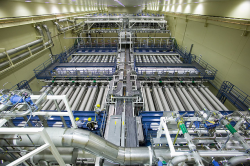The UK has teamed up with a US laser lab, hoping to develop clean energy from nuclear fusion

The new technology uses lasers to compress hydrogen atoms together until they fuse, releasing large amounts of energy.
Experiments at The National Ignition Facility (NIF) in the US have been promising, producing huge bursts of energy.
UK company AWE and the Rutherford Appleton Laboratory have now joined with NIF, attempting to make laser fusion a viable commercial energy source.
The NIF uses 192 laser beams, targeted at an area no more than 2mm containing extremely cold hydrogen isotopes, which when the laser is fired, are compressed until they fuse.
In the instant during which the NIF’s laser is fired, it uses more power than the combined electricity consumption of the whole of America.
But in a recent experiment, a burst of power was released from the fusion reaction that was equivalent to the entire world’s consumption.
The aim is to achieve “ignition” of the fuel- a self-sustaining fusion reaction that would release enough energy to far surpass the ‘break even’ point.
David Willets, the UK’s science minister said: “This is an absolutely classic example of the connections between really high-grade theoretical scientific research and a fundamental human need: our energy supply.”
